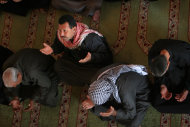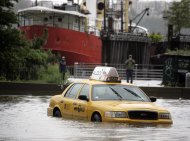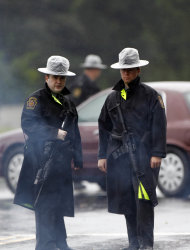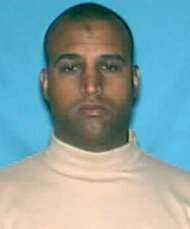Stripped of hurricane rank, Tropical Storm Irene spent the last of its fury Sunday, leaving treacherous flooding and millions without power — but an unfazed New York and relief that it was nothing like the nightmare authorities feared.
Slowly, the East Coast surveyed the damage — up to $7 billion by one private estimate. The center of Irene crossed into Canada late Sunday, but for many the danger had not passed.
Rivers and creeks turned into raging torrents tumbling with limbs and parts of buildings in northern New England and upstate New York. Flooding was widespread in Vermont, and hundreds of people were told to leave the capital, Montpelier, which could get flooded twice: once by Irene and once by a utility trying to save an overwhelmed dam.
Meanwhile, the nation's most populous region looked to a new week and the arduous process of getting back to normal.
New York lifted its evacuation order for 370,000 people and said subway service, shut down for the first time by a natural disaster, will be partially restored Monday, though it warned riders to expect long lines and long waits. Philadelphia restarted its trains and buses.
"All in all," New York Mayor Michael Bloomberg said, "we are in pretty good shape."
At least 21 people died in the storm, most of them when trees crashed through roofs or onto cars.
The main New York power company, Consolidated Edison, didn't have to go through with a plan to cut electricity to lower Manhattan to protect its equipment. Engineers had worried that salty seawater would damage the wiring.
And two pillars of the neighborhood came through the storm just fine: The New York Stock Exchange said it would be open for business on Monday, and the Sept. 11 memorial at the World Trade Center site didn't lose a single tree.
The center of Irene passed over Central Park at midmorning with the storm packing 65 mph winds. By late Sunday, it was down to 50 mph. Only tropical storm warnings for the south coast of New Brunswick and Nova Scotia remained in effect late Sunday, and those were expected to be lifted early Monday.
"Just another storm," said Scott Beller, who was at a Lowe's hardware store in the Long Island hamlet of Centereach, looking for a generator because his power was out.
The Northeast was spared the urban nightmare some had worried about — crippled infrastructure, stranded people and windows blown out of skyscrapers. Early assessments showed "it wasn't as bad as we thought it would be," New Jersey Gov. Chris Christie said.
Later in the day, the extent of the damage became clearer. Flood waters were rising across New Jersey, closing side streets and major highways including the New Jersey Turnpike and Interstate 295. In Essex County, authorities used a five-ton truck to ferry people away from their homes as the Passaic River neared its expected crest Sunday night.
Twenty homes on Long Island Sound in Connecticut were destroyed by churning surf. The torrential rain chased hundreds of people in upstate New York from their homes and washed out 137 miles of the state's main highway.
In Massachusetts, the National Guard had to help people evacuate. The ski resort town of Wilmington, Vt., was flooded, but nobody could get to it because both state roads leading there were underwater.
"This is the worst I've ever seen in Vermont," said Mike O'Neil, the state emergency management director.
Rivers roared in New Jersey and Pennsylvania. In the Hudson Valley town of New Paltz, N.Y., so many people were gathering to watch a rising river that authorities banned alcohol sales and ordered people inside. And in Rhode Island, which has a geography thick with bays, inlets and shoreline, authorities were worried about coastal flooding at evening high tide.
Chris Fogarty, director of the Canadian Hurricane Centre, warned of flooding and wind damage in eastern Canada and said the heaviest rainfall was expected in Quebec, where about 250,000 homes were without power.
The entire Northeast has been drenched this summer with what has seemed like relentless rain, saturating the ground and raising the risk of flooding, even after the storm passes altogether.
The storm system knocked out power for 4½ million people along the Eastern Seaboard. Power companies were picking through uprooted trees and reconnecting lines in the South and had restored electricity to hundreds of thousands of people by Sunday afternoon.
Under its first hurricane warning in a quarter-century, New York took extraordinary precautions. There were sandbags on Wall Street, tarps over subway grates and plywood on storefront windows.
The subway stopped rolling. Broadway and baseball were canceled.
With the worst of the storm over, hurricane experts assessed the preparations and concluded that, far from hyping the danger, authorities had done the right thing by being cautious.
Max Mayfield, former director of the National Hurricane Center, called it a textbook case.
"They knew they had to get people out early," he said. "I think absolutely lives were saved."
Mayfield credited government officials — but also the meteorologists. Days before the storm ever touched American land, forecast models showed it passing more or less across New York City.
"I think the forecast itself was very good, and I think the preparations were also good," said Keith Seitter, director of the American Meteorological Society. "If this exact same storm had happened without the preparations that everyone had taken, there would have been pretty severe consequences."
In the storm's wake, hundreds of thousands of passengers still had to get where they were going. Airlines said about 9,000 flights were canceled.
Officials said the three major New York-area airports will resume most flights Monday morning. Philadelphia International Airport reopened Sunday afternoon, and flights resumed around Washington, which took a glancing blow from the storm.
In the South, authorities still were not sure how much damage had been done. North Carolina Gov. Beverly Perdue said some parts of her state were unreachable. TV footage showed downed trees, toppled utility poles and power lines and mangled awnings.
Virginia Gov. Bob McDonnell had initially warned that Irene could be a "catastrophic" monster with record storm surges of up to 8 feet. But the mayor of Virginia Beach, Va., suggested on Twitter that the damage was not as bad as feared, as did the mayor of Ocean City, Md.
One of two nuclear reactors at Calvert Cliffs, Md., automatically went offline because of high winds. Constellation Energy Nuclear Group said the plant was safe.
In New York, some cabs were up to their wheel wells in water, and water rushed over a marina near the New York Mercantile Exchange, where gold and oil are traded. But the flooding was not extensive.
"Whether we dodged a bullet or you look at it and said, 'God smiled on us,' the bottom line is, I'm happy to report, there do not appear to be any deaths attributable to the storm," Bloomberg said.
New York officials could not pinpoint when transit service would be fully restored but warned that the Monday commute would be rough. The New York subway carries 5 million riders on an average weekday.
The casinos of Atlantic City, N.J., planned to reopen Monday at noon after state officials checked the integrity of the games, made sure the surveillance cameras work, and brought cash back into the cages under state supervision. All 11 casinos shut down for the storm, only the third time that has happened.
In Philadelphia, the mayor lifted the city's first state of emergency since 1986. The storm was blamed for the collapses of seven buildings, but no one was hurt and everyone was accounted for. People kept their eyes on the rivers. The Schuylkill was expected to reach 15 feet.
The 21 deaths attributed to the storm included six in North Carolina, four in Virginia, four in Pennsylvania, two in New York, two in rough surf in Florida and one each in Connecticut, Maryland and New Jersey.
In an early estimate, consulting firm Kinetic Analysis Corp. figured total losses from the storm at $7 billion, with insured losses of $2 billion to $3 billion. The storm will take a bite out of Labor Day tourist business from the Outer Banks to the Jersey Shore to Cape Cod.
Irene was the first hurricane to make landfall in the continental United States since 2008, and came almost six years to the day after Katrina ravaged New Orleans on Aug. 29, 2005.
As the East Coast cleans up, it can't afford to get too comfortable. Off the coast of Africa is a batch of clouds that computer models say will probably threaten the East Coast 10 days from now, Mayfield said. The hurricane center gave it a 40 percent chance of becoming a named storm over the next two days.
"Folks on the East Coast are going to get very nervous again," Mayfield said.










